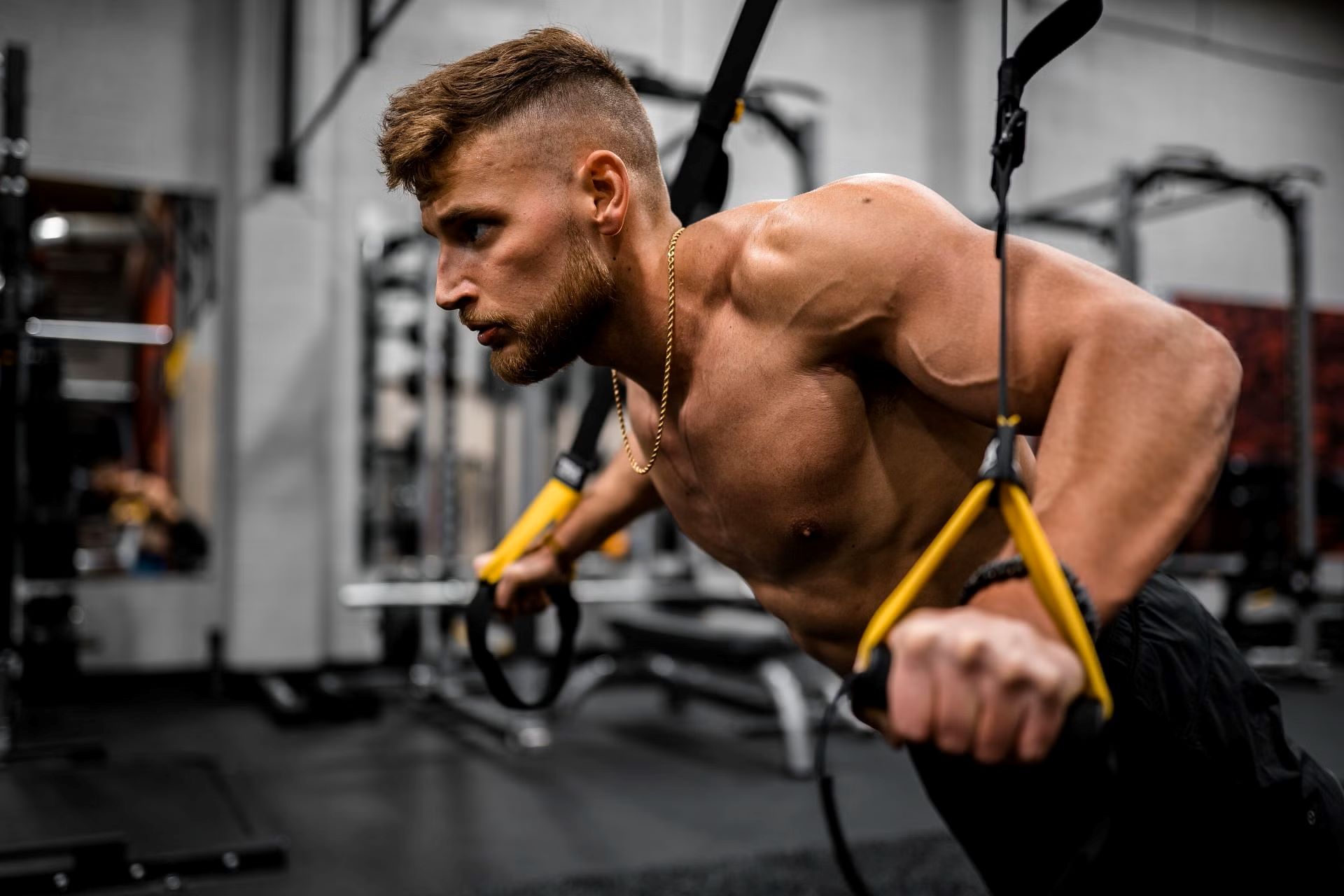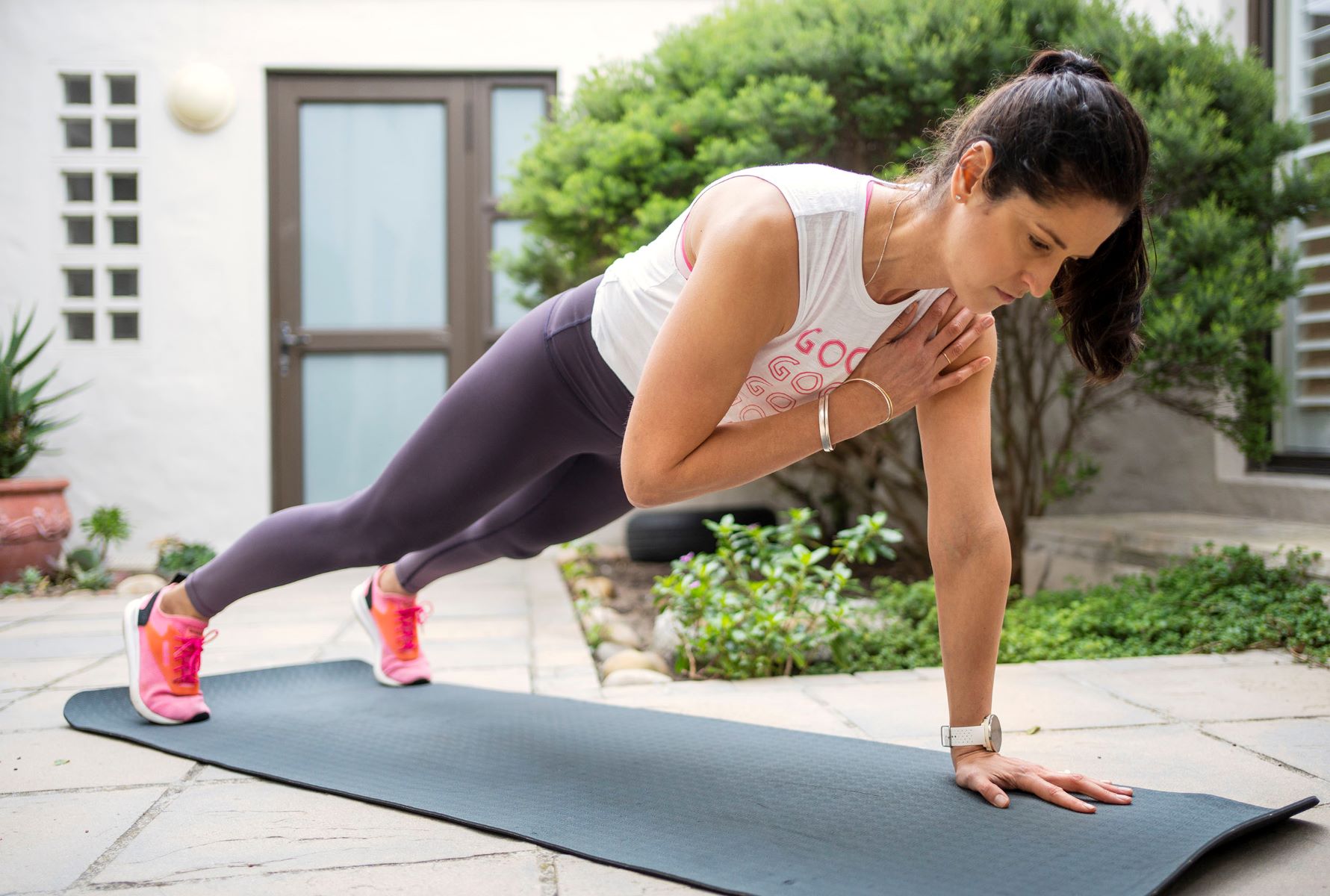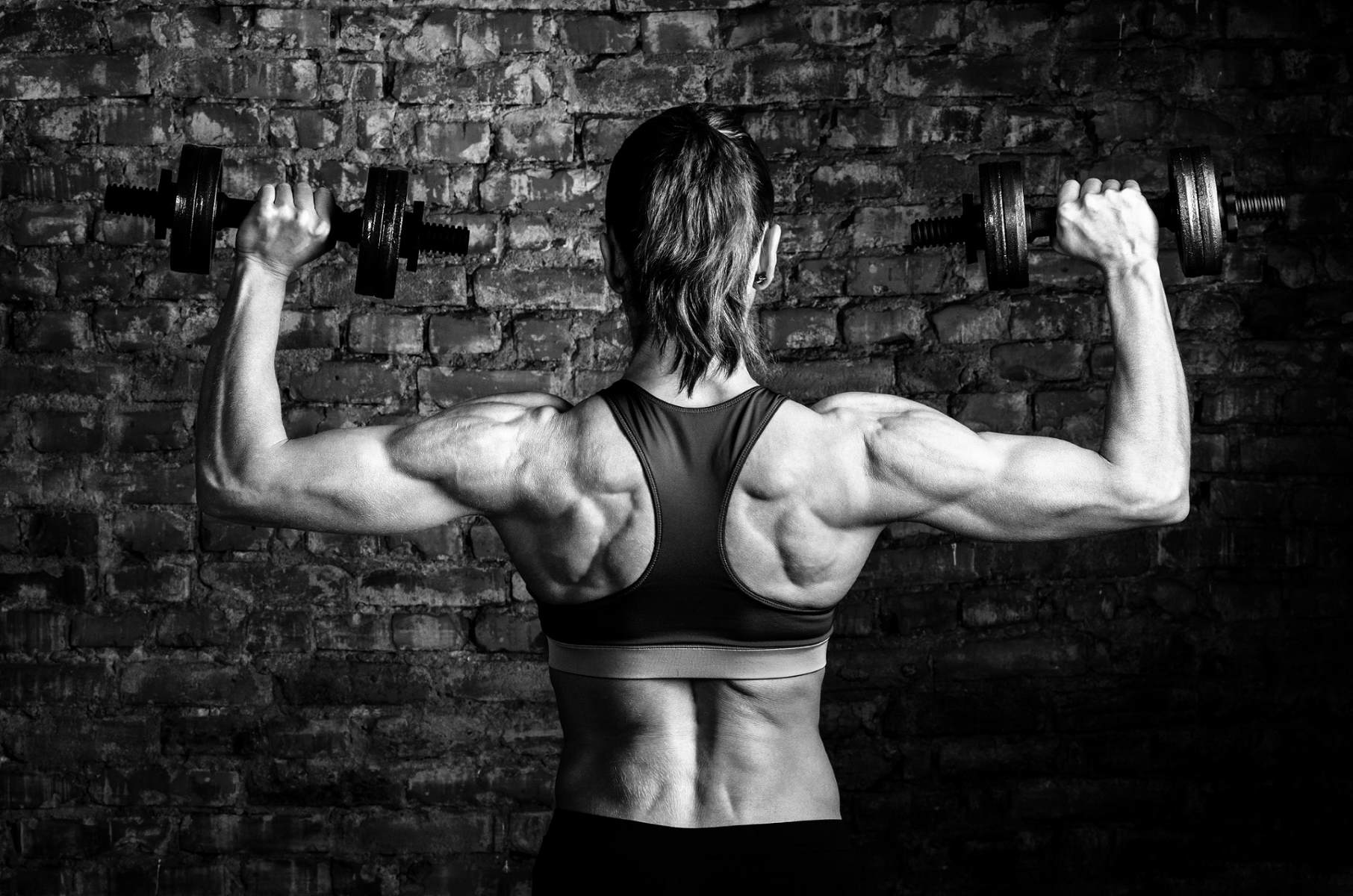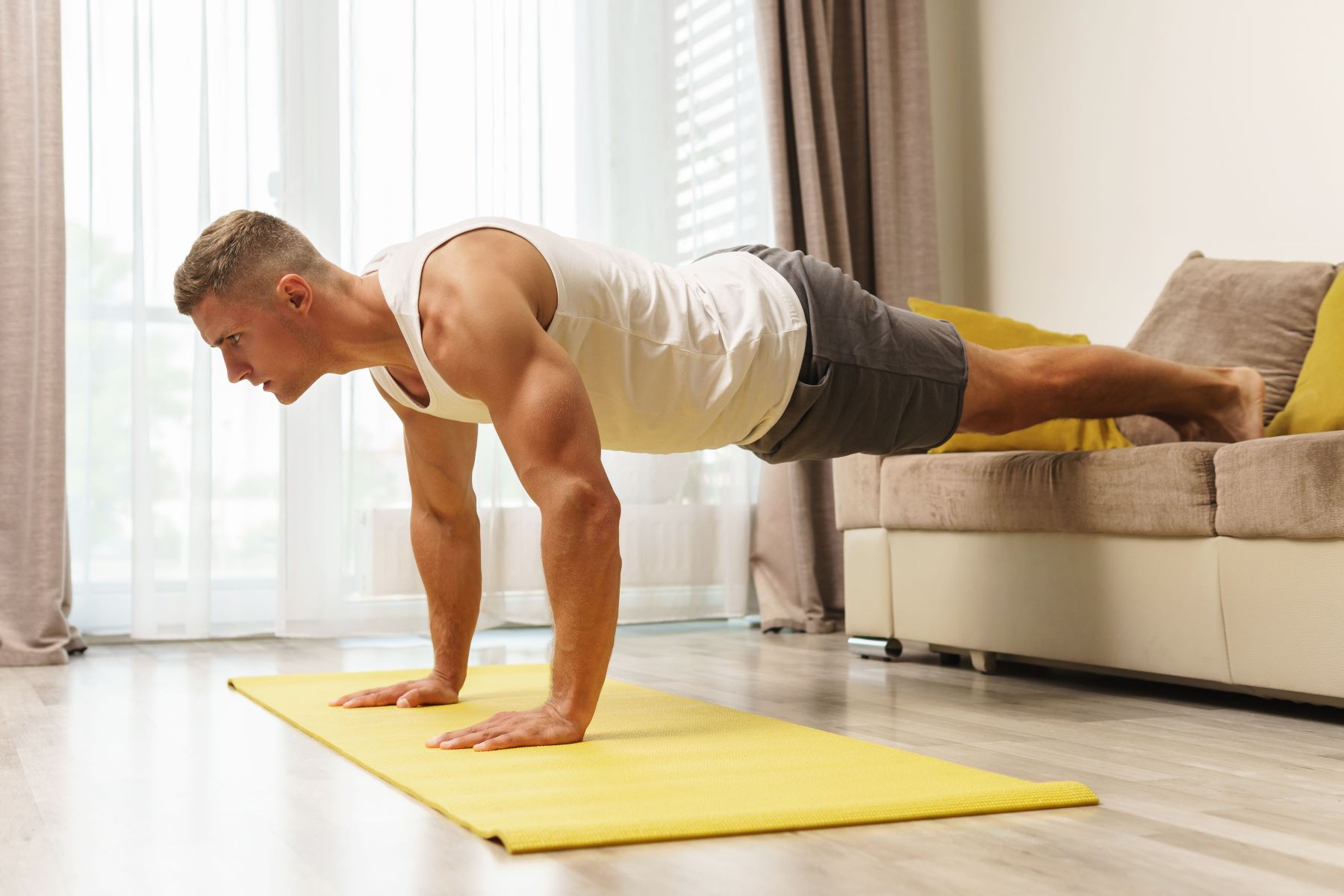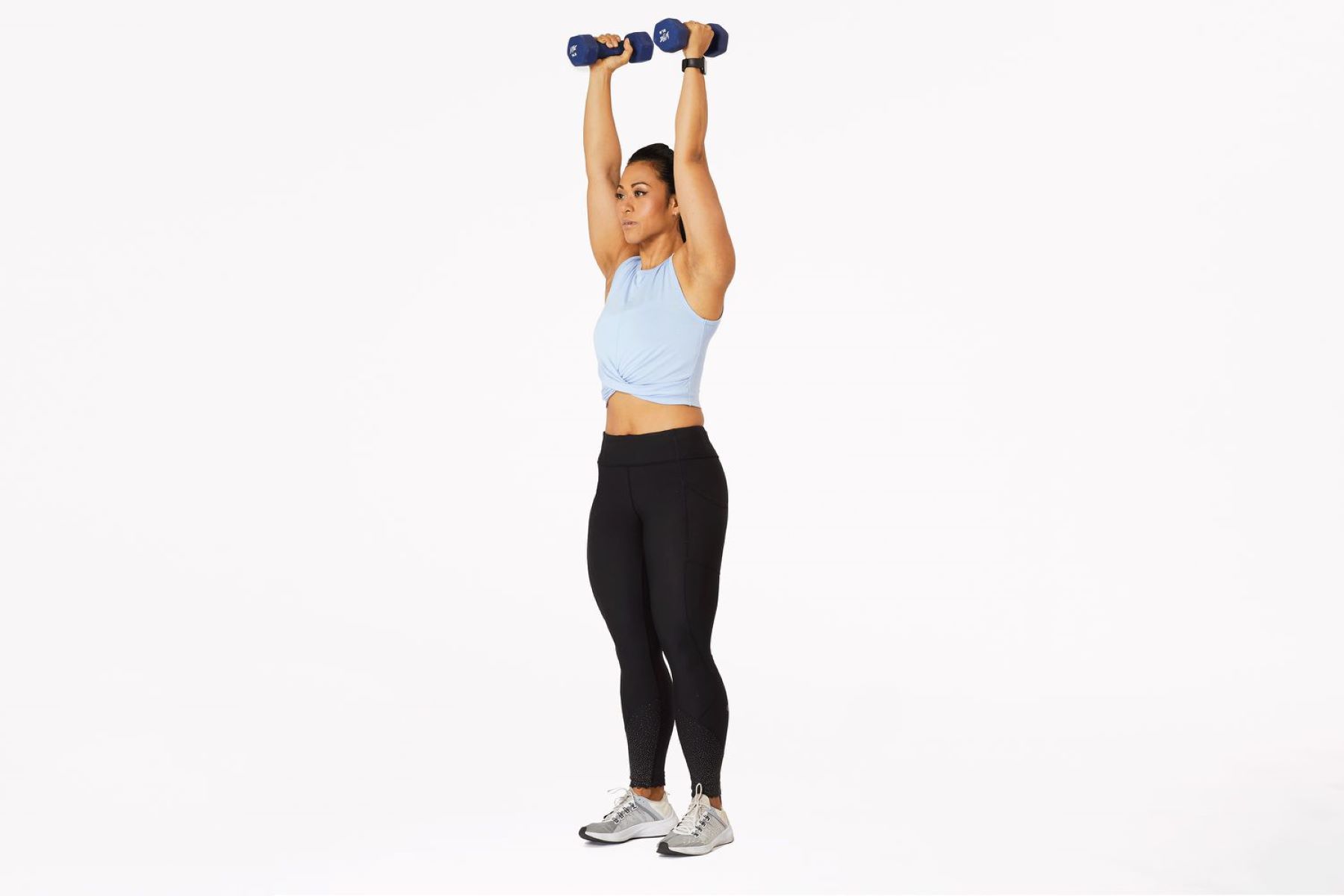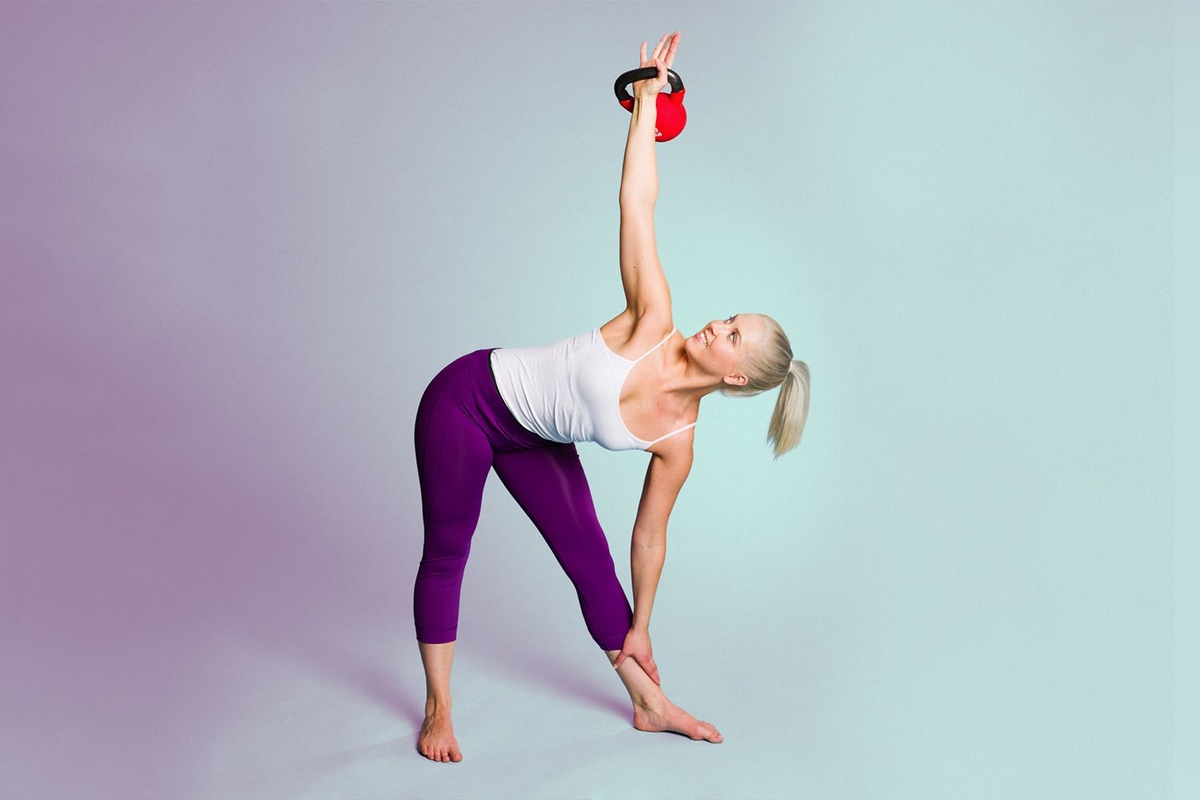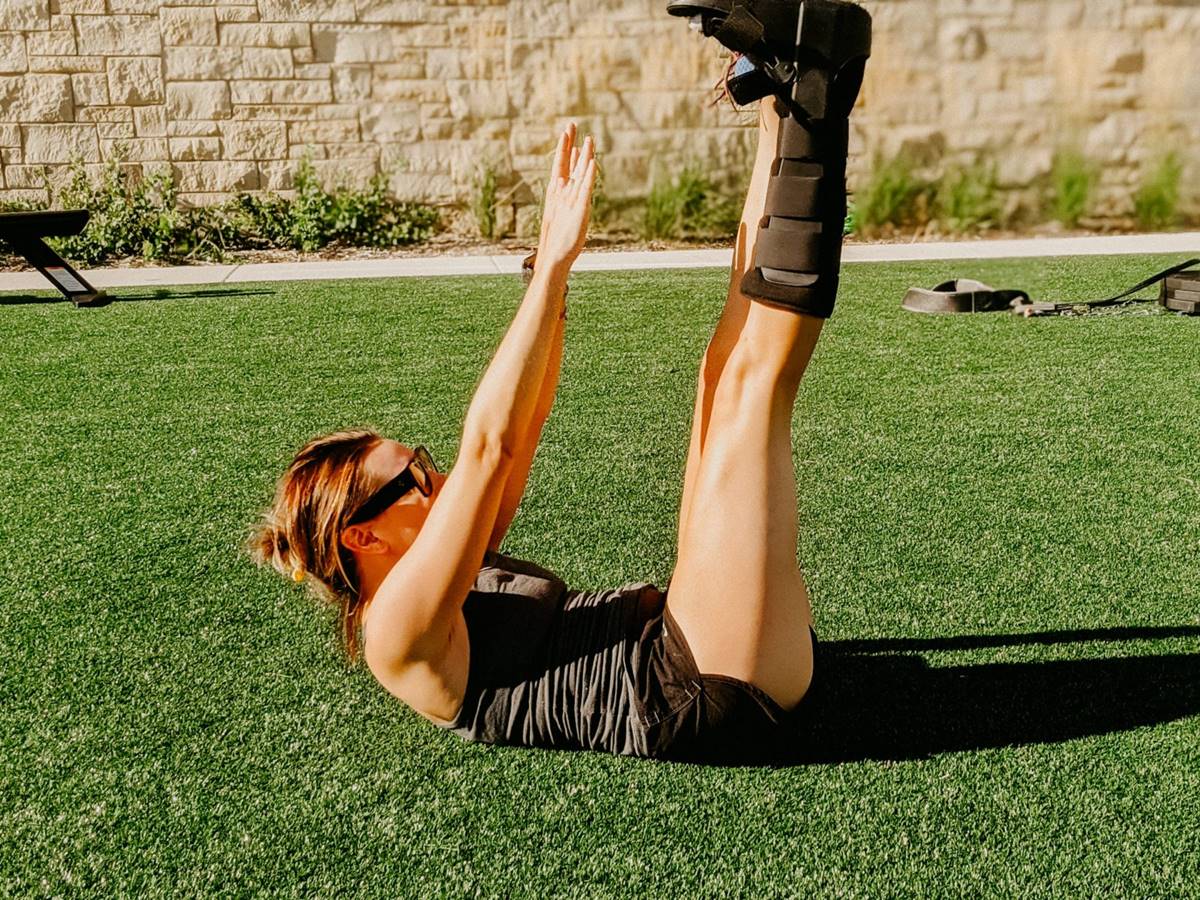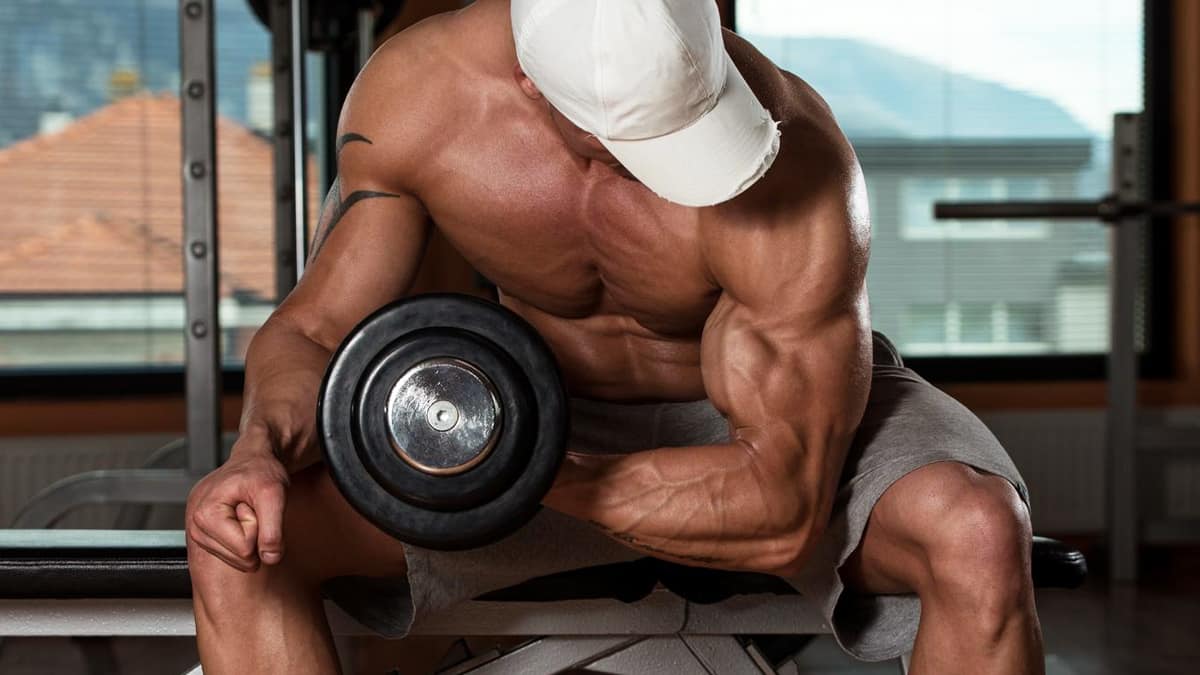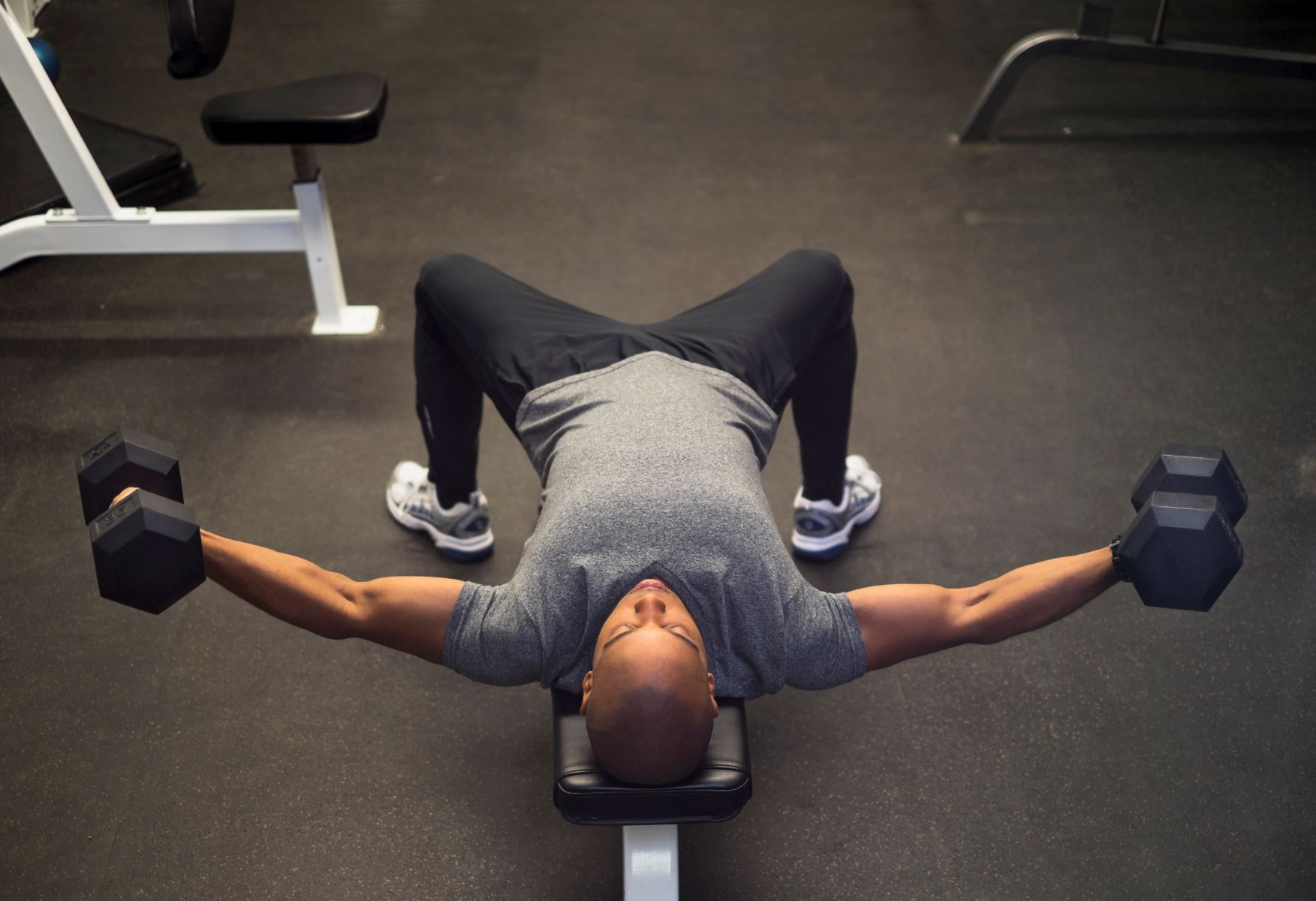

Featured
How To Workout Your Chest With Dumbbells
Modified: March 1, 2024
Discover the best dumbbell exercises for chest muscles and get a sculpted upper body. Learn effective chest workouts with dumbbells in our featured guide.
Introduction
Welcome to the world of dumbbell chest workouts! If you’re looking to build a strong and sculpted chest, dumbbell exercises are a fantastic option. Whether you’re new to working out or a seasoned fitness enthusiast, incorporating dumbbells into your routine can help you achieve your chest goals.
The chest muscles, also known as the pectoralis major and pectoralis minor, are responsible for various movements of the upper body, such as pushing and hugging motions. By targeting these muscles with dumbbell exercises, you can increase their strength, size, and definition.
One of the great advantages of using dumbbells for your chest workout is the freedom of movement they provide. Unlike barbells or machines that restrict your range of motion, dumbbells allow for a greater range of exercises and can help you target different areas of your chest effectively.
Moreover, dumbbell exercises engage stabilizer muscles, which are responsible for keeping your body stable during movements. This means you not only strengthen your chest muscles but also improve your overall stability and balance.
Whether you prefer working out at the gym or in the comfort of your home, dumbbell chest exercises offer a versatile and convenient way to train your chest muscles. With just a set of dumbbells and some space, you can get an effective chest workout without the need for complex equipment.
In this article, we’ll explore a variety of dumbbell exercises that target your chest muscles from different angles to maximize your results. We’ll also provide tips on how to prepare for your workout, cool-down and stretch afterward, and make the most out of your dumbbell chest routine.
So, grab your dumbbells, get ready to sweat, and let’s dive into the world of dumbbell chest exercises that will help you achieve a strong, chiseled chest!
Benefits of Working Out Your Chest with Dumbbells
When it comes to working out your chest, dumbbells offer several key benefits that make them a valuable addition to your fitness routine. Here are some of the advantages of incorporating dumbbell exercises into your chest workout:
1. Greater Range of Motion: Dumbbells allow for a wider range of motion compared to barbells or machines. This increased range of motion activates more muscle fibers in your chest, leading to greater muscle activation and development.
2. Balanced Development: With dumbbells, each arm is responsible for lifting its own weight. This helps build balanced strength and muscle development on both sides of your chest, preventing muscular imbalances and reducing the risk of injuries.
3. Engages Stabilizer Muscles: Dumbbell exercises require more control and stability than exercises performed on machines. This means your stabilizer muscles, such as your core, shoulders, and triceps, are actively engaged throughout the movement, helping improve overall balance and coordination.
4. Versatility and Variety: Dumbbells offer endless exercise variations, allowing you to target different areas of your chest. Whether you want to focus on your upper, middle, or lower chest, there are numerous dumbbell exercises that can help you achieve your specific goals.
5. Convenient and Accessible: Dumbbells are readily available at most gyms and can be easily purchased for home use. They are compact and portable, making them a convenient option for those who prefer to work out at home or on the go.
6. Functional Strength: Dumbbell exercises mimic natural movements like pushing and hugging motions, which are commonly performed in daily activities. By strengthening your chest with dumbbells, you improve your functional strength, making it easier to perform everyday tasks and activities.
7. Progressive Overload: Dumbbells allow you to easily adjust the weight and incrementally increase the load as you become stronger. This progressive overload stimulates muscle growth and helps you continually challenge your chest muscles for ongoing gains.
By incorporating dumbbell exercises into your chest workout, you can reap these benefits and take your chest training to the next level. Whether you’re aiming to increase strength, build muscle, or improve overall chest aesthetics, dumbbell workouts provide a highly effective and efficient method to achieve your goals.
Preparing for Your Dumbbell Chest Workout
Before diving into your dumbbell chest workout, it’s important to properly prepare your body to ensure a safe and effective training session. Here are some essential steps to follow when getting ready for your workout:
1. Warm-Up: Begin your chest workout with a dynamic warm-up to increase blood flow to the muscles and prepare them for the upcoming exercises. Perform exercises such as arm circles, shoulder rolls, and bodyweight exercises like jumping jacks or push-ups to warm up your upper body.
2. Choose the Right Dumbbells: Select dumbbells that are appropriate for your fitness level and goals. Start with lighter weights if you’re a beginner and gradually increase the weight as you become stronger and more comfortable with the movements.
3. Proper Form and Technique: Before starting each exercise, familiarize yourself with the proper form and technique. Pay attention to your posture, maintain a stable core, and focus on the targeted muscle group. Performing exercises with correct form helps prevent injuries and maximizes the effectiveness of the workout.
4. Start with Compound Exercises: Begin your chest workout with compound exercises that target multiple muscle groups simultaneously. Exercises like the flat dumbbell bench press and incline dumbbell press engage not only your chest muscles but also your shoulders and triceps, providing a comprehensive upper body workout.
5. Utilize Proper Grips: Experiment with different grips to target specific areas of your chest. A neutral grip, in which your palms face each other, focuses more on the inner chest, while a pronated grip, with your palms facing forward, targets the outer chest. Switching grips can add variety and stimulate different muscle fibers.
6. Rest and Recovery: Don’t forget to incorporate rest days into your training schedule. Allow your chest muscles time to recover and adapt to the stress of your workouts. Adequate rest is essential for muscle growth and injury prevention.
7. Hydration and Nutrition: Stay hydrated before, during, and after your workout. Drink plenty of water to keep your body fueled and functioning optimally. Additionally, fuel your body with a balanced diet that includes protein to support muscle growth and repair.
By following these preparation steps, you can set yourself up for a successful and productive dumbbell chest workout. Remember to listen to your body and adjust the weights and intensity as needed. With proper preparation, you’ll be ready to conquer your chest exercises and work toward achieving your fitness goals.
Flat Dumbbell Bench Press
The flat dumbbell bench press is a classic chest exercise that primarily targets the pectoralis major muscles, with secondary involvement from the triceps and shoulders. Here’s how to perform the flat dumbbell bench press:
Step 1: Begin by sitting on a flat bench with a dumbbell in each hand. Place the dumbbells on your thighs, palms facing inward.
Step 2: Slowly lay back on the bench, bringing the dumbbells to shoulder level with your elbows bent. Keep your feet firmly planted on the ground for stability.
Step 3: Engage your core and press the dumbbells upward until your arms are fully extended. Keep your wrists straight and aligned with your forearms throughout the movement.
Step 4: Lower the dumbbells back down to shoulder level, maintaining control and a slow, controlled tempo. Avoid letting the dumbbells touch your chest to maintain tension in your chest muscles.
Step 5: Repeat for the desired number of repetitions.
Tips for Flat Dumbbell Bench Press:
- Start with lighter weights to ensure correct form and gradually increase the weight as you become more comfortable and stronger.
- Keep your shoulder blades squeezed together throughout the exercise to provide stability and protect your shoulders.
- Exhale as you press the dumbbells up and inhale as you lower them down, maintaining controlled breathing throughout the movement.
- Consider using a spotter, especially when lifting heavier weights, to ensure safety and proper execution.
Incorporate the flat dumbbell bench press into your chest routine to effectively target your pectoral muscles and build strength and size in your chest. As with any exercise, proper form, controlled movements, and gradual progression are essential for optimal results.
Dumbbell Chest Flyes
Dumbbell chest flyes are an excellent exercise for isolating and strengthening your chest muscles, particularly the pectoralis major. This exercise primarily focuses on the inner and upper chest muscles. Here’s how to perform dumbbell chest flyes:
Step 1: Lie down on a flat bench and hold a dumbbell in each hand. Extend your arms toward the ceiling, palms facing each other, and allow a slight bend in your elbows.
Step 2: Keeping a slight bend in your elbows, inhale and lower your arms out to the sides in a wide arc motion. Lower the dumbbells until your elbows are parallel to the bench or until you feel a stretch in your chest.
Step 3: Exhale and engage your chest muscles to bring the dumbbells back up to the starting position. Be sure to maintain control and avoid using excessive momentum.
Step 4: Repeat for the desired number of repetitions.
Tips for Dumbbell Chest Flyes:
- Focus on maintaining a slight bend in your elbows throughout the exercise to keep tension on your chest muscles.
- Engage your core muscles to stabilize your body throughout the movement.
- Avoid dropping the weights too low, as this can strain your shoulder joints. Instead, aim to feel a stretch in your chest without discomfort.
- Control your breathing and exhale as you bring the dumbbells together and inhale as you lower them down.
- Gradually increase the weight as you become stronger, but always prioritize maintaining proper form.
Incorporating dumbbell chest flyes into your workout routine helps to develop a well-rounded chest by targeting the inner and upper portions of your pectoral muscles. Remember to start with lighter weights and focus on form before progressing to heavier loads. Consistency and proper execution are essential for gaining the full benefits of this exercise.
Incline Dumbbell Press
The incline dumbbell press is a highly effective exercise for targeting the upper chest muscles, specifically the upper fibers of the pectoralis major. By performing this exercise on an inclined bench, you can isolate and activate the upper chest to add definition and fullness to your overall chest development. Here’s how to perform the incline dumbbell press:
Step 1: Set an adjustable bench to a 30-45 degree incline. Sit down on the bench and hold a dumbbell in each hand at shoulder level, palms facing forward.
Step 2: Plant your feet firmly on the ground for stability and ensure your back is flat against the bench. Engage your core for stability throughout the exercise.
Step 3: Inhale and push the dumbbells upward, extending your arms fully. Be sure to keep your wrists straight and aligned with your forearms.
Step 4: Exhale and slowly lower the dumbbells back down to shoulder level, maintaining control and a slow, controlled tempo. Avoid letting the dumbbells touch your chest to keep tension on the chest muscles.
Step 5: Repeat for the desired number of repetitions.
Tips for Incline Dumbbell Press:
- Start with lighter weights to ensure proper form and gradually increase the weight as you become more comfortable and stronger.
- Maintain a slight bend in your elbows throughout the exercise to keep tension on your chest muscles.
- Keep your shoulder blades squeezed together and your chest lifted for optimal muscle engagement.
- Control your breathing and exhale as you push the dumbbells up and inhale as you lower them down.
- Consider using a spotter, especially when lifting heavier weights, to ensure safety and proper execution.
Incorporating incline dumbbell presses into your chest routine helps target the upper chest muscles, creating a well-rounded and proportioned chest. Ensure that you maintain proper form and gradually increase the weight to continue challenging your muscles and promoting growth. As with any exercise, consistency and proper execution are key to achieving optimal results.
Decline Dumbbell Bench Press
The decline dumbbell bench press is a variation of the traditional bench press that targets the lower chest muscles, particularly the lower fibers of the pectoralis major. By performing this exercise on a decline bench, you can emphasize the lower chest and sculpt a well-defined and balanced chest. Here’s how to properly execute the decline dumbbell bench press:
Step 1: Set a decline bench at a 30-45-degree angle. Lie down on the bench with a dumbbell in each hand, palms facing forward.
Step 2: Plant your feet securely on the ground, ensuring proper stability and support throughout the exercise. Position yourself with your head lower than your lower body.
Step 3: Inhale and lower the dumbbells down towards your lower chest, keeping your elbows at a 45-degree angle to your sides. Maintain control and a slow, controlled tempo.
Step 4: Exhale and push the dumbbells back up to the starting position, extending your arms fully. Focus on contracting your chest muscles as you press upwards.
Step 5: Repeat for the desired number of repetitions.
Tips for Decline Dumbbell Bench Press:
- Start with lighter weights to ensure proper form and gradually increase the weight as you become more comfortable and stronger.
- Maintain a slight bend in your elbows throughout the exercise to keep tension on your chest muscles.
- Keep your shoulder blades squeezed together and your chest lifted for optimal muscle engagement.
- Control your breathing and exhale as you push the dumbbells up and inhale as you lower them down.
- Consider using a spotter, especially when lifting heavier weights, to ensure safety and proper execution.
Adding the decline dumbbell bench press to your chest routine helps target the lower chest muscles, providing a balanced and sculpted chest appearance. Remember to focus on maintaining proper form and gradually increase the weight as you progress. Consistency and proper execution are key to maximizing the benefits of this exercise.
Dumbbell Pullover
The dumbbell pullover is a unique exercise that targets multiple muscle groups, including the chest, back, and even the triceps. It is an excellent exercise for developing overall upper body strength and stability. The primary focus of the dumbbell pullover is on the chest muscles. Here’s how to perform the dumbbell pullover:
Step 1: Lie down on a flat bench with your head and upper back supported. Hold a dumbbell with both hands, arms extended overhead, and palms facing up.
Step 2: Maintain a slight bend in your elbows as you lower the dumbbell behind your head in an arc motion. This position should feel like you are stretching your chest muscles.
Step 3: Engage your chest muscles and pull the dumbbell back up to the starting position, keeping your arms extended and controlled throughout the movement.
Step 4: Repeat for the desired number of repetitions.
Tips for Dumbbell Pullover:
- Start with a lighter weight to ensure proper form and gradually increase the weight as you become more comfortable and stronger.
- Maintain a slight bend in your elbows throughout the exercise to keep tension on your chest muscles.
- Keep your core engaged and your lower back firmly planted on the bench for stability.
- Control your breathing and exhale as you pull the dumbbell back up and inhale as you lower it behind your head.
- Ensure a full range of motion by lowering the dumbbell as far as comfortable without straining your shoulders or back.
The dumbbell pullover is a versatile exercise that can be included in your chest workout routine to activate and strengthen your chest muscles. It also helps improve stability and flexibility in the upper body. Remember to focus on proper form and controlled movements to get the most out of this exercise. Incorporate dumbbell pullovers into your routine to add variety and challenge to your chest workout.
Push-ups with Dumbbell Variation
Push-ups with a dumbbell variation add an extra challenge to the traditional push-up exercise by incorporating the use of dumbbells. This variation not only targets the chest muscles but also engages the shoulders, triceps, and core. Here’s how to perform push-ups with a dumbbell variation:
Step 1: Start in a standard push-up position with your hands slightly wider than shoulder-width apart on a pair of dumbbells. Keep your body in a straight line from your head to your heels.
Step 2: Lower your chest toward the ground, maintaining a controlled and steady tempo. Keep your elbows at a 45-degree angle to your body.
Step 3: Push through your chest, shoulders, and triceps to lift your body back to the starting position.
Step 4: Repeat for the desired number of repetitions.
Tips for Push-ups with Dumbbell Variation:
- Choose dumbbells that are stable and won’t roll or shift during the exercise.
- Engage your core and maintain a straight line from your head to your heels throughout the movement.
- Control your breathing by exhaling as you push up and inhaling as you lower yourself down.
- Start with a modified version of push-ups, such as kneeling or inclined push-ups, if the full variation is too challenging at first.
- Focus on maintaining proper form and range of motion rather than the number of repetitions.
Push-ups with a dumbbell variation provide an excellent way to add intensity and resistance to your chest workout. This exercise not only targets the chest muscles but also engages supporting muscle groups, promoting overall upper body strength and stability. Incorporating this variation into your routine will add variety and challenge, helping you to further develop your chest muscles and improve your overall fitness level.
Dumbbell Squeeze Press
The dumbbell squeeze press is a unique exercise that not only targets the chest muscles but also engages the inner and outer muscles of the pecs. This exercise helps to build strength, size, and definition in the chest while also improving stability and balance. Here’s how to perform the dumbbell squeeze press:
Step 1: Lie down on a flat bench with a dumbbell in each hand, palms facing inward. Extend your arms straight above your chest, keeping a slight bend in your elbows.
Step 2: Bring the dumbbells close together, allowing them to touch each other. This is your starting position.
Step 3: While maintaining the connection between the dumbbells, slowly lower them down towards your chest, keeping your elbows at a 45-degree angle to your torso. Focus on feeling the squeeze in your chest muscles as you lower the weight.
Step 4: Press the dumbbells back up to the starting position, keeping the squeeze between the dumbbells. Contract your chest muscles as you push the weight up.
Step 5: Repeat for the desired number of repetitions.
Tips for Dumbbell Squeeze Press:
- Choose a weight that challenges you while still allowing you to maintain proper form and technique.
- Focus on keeping a tight squeeze between the dumbbells throughout the entire movement.
- Engage your core and keep your back flat against the bench to maintain stability and prevent strain on your lower back.
- Control your breathing and exhale as you press the dumbbells up and inhale as you lower them down.
- Gradually increase the weight as you become stronger and more comfortable with the exercise.
Incorporating the dumbbell squeeze press into your chest routine adds a unique element by emphasizing the contraction of the chest muscles. This exercise helps to improve the mind-muscle connection and can lead to greater chest activation and development. With proper form and progressive overload, the dumbbell squeeze press can be a valuable addition to your chest workout routine.
Single Arm Dumbbell Bench Press
The single arm dumbbell bench press is a challenging exercise that targets the chest muscles while also engaging the stabilizer muscles in the shoulders, core, and arms. This unilateral exercise helps to correct any muscle imbalances and develop overall strength and stability in the chest. Here’s how to perform the single arm dumbbell bench press:
Step 1: Sit on a flat bench with a dumbbell in one hand, palm facing inward. Position the dumbbell at shoulder level with your elbow bent.
Step 2: Plant your feet firmly on the ground, ensuring stability and balance. Keep your back straight and engaged throughout the exercise.
Step 3: Inhale and push the dumbbell upward, extending your arm fully. Make sure to keep your core engaged and avoid excessive movement in your torso.
Step 4: Exhale and slowly lower the dumbbell back down to shoulder level, maintaining control and a slow, controlled tempo. Avoid letting the dumbbell touch your chest to maintain tension in your chest muscles.
Step 5: Repeat for the desired number of repetitions on one side, then switch to the other arm.
Tips for Single Arm Dumbbell Bench Press:
- Choose a weight that challenges you while still allowing you to maintain proper form and technique.
- Keep your shoulder blades squeezed together and your chest lifted for optimal muscle engagement.
- Control your breathing and exhale as you push the dumbbell up and inhale as you lower it down.
- Maintain stability by keeping your non-working arm extended to the side or resting on your thigh.
- Start with lighter weights and progress gradually to heavier loads as you become more comfortable and stronger.
The single arm dumbbell bench press is a fantastic exercise for developing unilateral strength and correcting any muscle imbalances in the chest. It challenges not only your chest muscles but also your stabilizer muscles, enhancing overall upper body stability. Incorporate this exercise into your chest routine to improve symmetry, boost strength, and enhance the effectiveness of your chest workout.
Dumbbell Chest Press on Stability Ball
The dumbbell chest press on a stability ball is an effective exercise that engages the chest muscles, as well as the stabilizer muscles in the core and shoulders. By performing this exercise on an unstable surface, such as a stability ball, you further challenge your muscles’ stability and balance. Here’s how to properly execute the dumbbell chest press on a stability ball:
Step 1: Sit on a stability ball with your feet firmly planted on the ground, hip-width apart. Walk your feet forward, allowing the ball to roll under your back until your head, neck, and shoulder blades are supported on the ball.
Step 2: Hold a dumbbell in each hand, palms facing forward, and extend your arms toward the ceiling. Your elbows should be slightly bent.
Step 3: Engage your core and glutes to maintain stability on the ball. Lower the dumbbells down towards your chest, keeping your elbows at a 45-degree angle to your torso.
Step 4: Push the dumbbells back up to the starting position, fully extending your arms. Focus on engaging your chest muscles as you press the weight up.
Step 5: Repeat for the desired number of repetitions.
Tips for Dumbbell Chest Press on Stability Ball:
- Choose dumbbells that challenge you while still allowing you to maintain proper form and stability on the ball.
- Keep your shoulder blades squeezed together and your chest lifted throughout the exercise.
- Maintain a controlled and steady tempo throughout the movement, avoiding any sudden movements.
- Control your breathing and exhale as you push the dumbbells up and inhale as you lower them down.
- Ensure proper alignment by keeping your head, neck, and shoulders supported on the stability ball.
The dumbbell chest press on a stability ball is a dynamic exercise that challenges both your chest muscles and your core stability. By incorporating this exercise into your chest routine, you can improve coordination, balance, and muscle engagement. Remember to start with lighter weights and gradually increase the resistance as you become more comfortable and confident on the stability ball.
Dumbbell Floor Press
The dumbbell floor press is a versatile exercise that targets the chest muscles, particularly the triceps and shoulders, while providing stability and support through the floor. This variation of the traditional bench press is especially beneficial for individuals with limited shoulder range of motion or those looking to switch up their chest workout routine. Here’s how to perform the dumbbell floor press:
Step 1: Lie flat on your back on the floor with your knees bent and feet flat on the ground. Hold a dumbbell in each hand, palms facing inward, and position your arms to the side of your chest with your elbows forming a 90-degree angle.
Step 2: Maintain a slight arch in your lower back and press your shoulder blades firmly into the floor for stability throughout the exercise.
Step 3: Inhale and push the dumbbells upward, extending your arms fully. Keep your wrists straight and aligned with your forearms throughout the movement.
Step 4: Exhale and slowly lower the dumbbells back down to the starting position, maintaining control and a slow, controlled tempo. Stop just short of your elbows touching the floor to maintain tension in your chest muscles.
Step 5: Repeat for the desired number of repetitions.
Tips for Dumbbell Floor Press:
- Choose dumbbells that challenge you while still allowing you to maintain proper form and control.
- Keep your shoulder blades and entire upper back in contact with the floor throughout the exercise.
- Engage your core and maintain a neutral spine throughout the movement.
- Control your breathing and exhale as you push the dumbbells up and inhale as you lower them down.
- Gradually increase the weight as you become more comfortable and stronger.
The dumbbell floor press is a convenient and effective exercise that can be performed at home or in the gym. It provides a stable base while targeting your chest muscles and is an excellent option for individuals with limited access to benches or those aiming to vary their chest training routine. Incorporate the dumbbell floor press into your chest workouts to build strength and definition in your chest muscles.
Cool-Down and Stretching Exercises
After completing your dumbbell chest workout, it’s important to cool down and stretch your muscles to promote recovery, reduce muscle soreness, and prevent injuries. Here are some effective cool-down and stretching exercises for your chest muscles:
1. Chest Stretch: Stand tall and interlace your fingers behind your back. Gently squeeze your shoulder blades together and lift your arms upward, feeling a stretch across your chest. Hold for 15-30 seconds and repeat.
2. Shoulder Roll: Stand with your feet hip-width apart and relax your arms by your sides. Roll your shoulders forward and upward in a circular motion, then roll them backward and downward. Repeat for 10-15 seconds in each direction.
3. Arm Across Chest Stretch: Extend one arm across your chest, using the opposite hand to gently pull the arm closer to your body until you feel a stretch in your shoulder and the back of your arm. Hold for 15-30 seconds on each side.
4. Cat-Cow Stretch: Come to an all-fours position with your hands under your shoulders and knees under your hips. Inhale as you arch your back and lift your chest (cow pose), then exhale as you round your spine and tuck your chin to your chest (cat pose). Repeat for 5-10 rounds.
5. Child’s Pose: Sit back on your heels and lower your upper body toward the floor, outstretching your arms in front of you. Rest your forehead on the mat and relax, allowing your chest to sink towards the ground. Hold for 30 seconds to 1 minute.
6. Neck Stretch: Sit or stand with your spine tall. Tilt your head gently to one side, bringing your ear towards your shoulder until you feel a stretch in the side of your neck. Hold for 15-30 seconds on each side.
7. Deep Breathing: Finish off your cool-down with a few minutes of deep breathing. Inhale deeply through your nose, filling your belly with air, and exhale slowly through your mouth, releasing any tension or stress. Focus on relaxing your body and mind.
Remember to listen to your body and modify or skip stretches that feel uncomfortable or painful. Stretching should feel like a gentle pull, not a sharp or intense sensation. Cool-down exercises and stretches are crucial for promoting muscle recovery and flexibility, so be sure to include them in your post-workout routine.
Tips for Maximizing Your Chest Workout with Dumbbells
To get the most out of your chest workout with dumbbells, it’s important to have a solid plan and implement strategies that will help you maximize your results. Here are some valuable tips to help you optimize your chest workout:
1. Focus on Form: Proper form is key to effectively targeting and engaging your chest muscles. Pay attention to your posture, alignment, and range of motion during each exercise. This ensures that you’re effectively working your chest muscles and reduces the risk of injury.
2. Use a Full Range of Motion: Aim to achieve a full range of motion on each repetition. This means lowering the weight until you feel a stretch in your chest and fully extending your arms on the concentric phase of the exercise. Opting for a complete range of motion helps activate more muscle fibers and leads to greater muscle development.
3. Implement Progressive Overload: To continuously challenge your chest muscles and promote growth, progressively increase the weight or intensity over time. Gradually adding more resistance ensures that your muscles are continually stimulated and adapting to the demands placed upon them.
4. Vary Your Grips and Angles: Experiment with different grips and angles on exercises like presses and flyes to target different areas of your chest. Mixing up your grip can help emphasize certain parts of your chest, such as the inner or outer muscles, providing a well-rounded development.
5. Mix Compound and Isolation Exercises: Incorporate a combination of compound exercises, such as bench press and push-ups, with isolation exercises like flyes and pullovers. Compound movements engage multiple muscle groups simultaneously, while isolation exercises allow for a more focused and targeted contraction of the chest muscles.
6. Prioritize Rest and Recovery: Allow your chest muscles ample time to recover between workouts. Muscle growth occurs during the rest and recovery period, so ensure you’re giving your chest muscles enough time to repair and rebuild. Incorporate rest days and focus on other muscle groups while allowing your chest muscles to recover.
7. Maintain Consistency: Consistency is key in any training program. Aim for regular chest workouts that challenge your muscles without overtraining. Find a workout schedule that works for you and stick to it to see gradual progress over time.
8. Listen to your Body: Pay attention to how your body responds to different exercises and adjust accordingly. If an exercise causes pain or discomfort, switch to a modified version or consult with a fitness professional for guidance. It’s important to prioritize safety and listen to your body’s signals.
9. Fuel Your Body Properly: Ensure you’re providing your body with adequate nutrition and hydration. Eat a balanced diet that includes protein, carbohydrates, and healthy fats to support muscle growth and recovery. Proper hydration is also essential for optimal performance and recovery.
10. Challenge Yourself: Continually challenge yourself by increasing the weight, reps, or sets as you progress. Your body adapts to the demands placed upon it, so it’s important to consistently push yourself within safe limits to see continued improvements in strength and muscle development.
By implementing these tips, you can maximize your chest workout and achieve your desired results with dumbbells. Remember to always prioritize safety, proper form, and gradual progression to ensure a safe and effective training experience.
Conclusion
Congratulations! You now have a comprehensive understanding of how to maximize your chest workout with dumbbells. Incorporating dumbbell exercises into your routine offers a versatile and effective way to target your chest muscles while engaging stabilizer muscles and enhancing overall strength and stability.
By following the tips provided, such as focusing on proper form, using a full range of motion, progressively overloading, and varying your grips and angles, you can optimize your chest workout and achieve the results you desire. Consistency, persistence, and listening to your body are key factors in making progress and avoiding injury.
Remember to always warm up before starting your workout, choose appropriate dumbbell weights, and cool down with stretching to promote muscle recovery and flexibility. Additionally, ensuring proper nutrition and hydration will support your muscle growth and overall fitness journey.
Whether you’re a beginner or an experienced fitness enthusiast, the variety of exercises outlined in this article, from the flat dumbbell bench press to the dumbbell floor press, can be tailored to your fitness level and goals. Challenge yourself, experiment with different exercises, and find the routine that works best for you.
So go ahead, grab those dumbbells, and embark on your journey to develop a strong, sculpted chest. With dedication, consistency, and these valuable tips, you’re well on your way to achieving the chest of your dreams.
